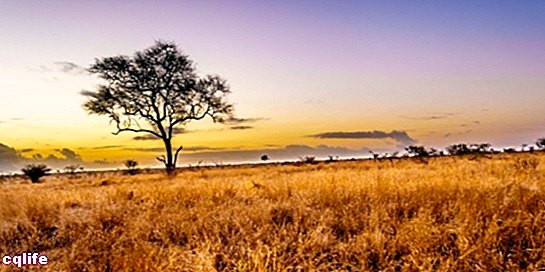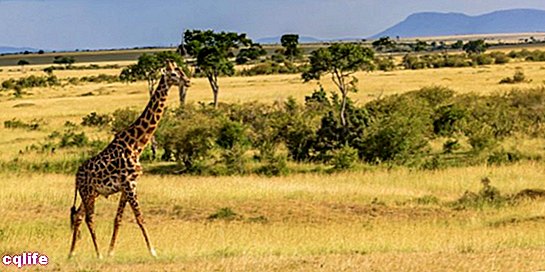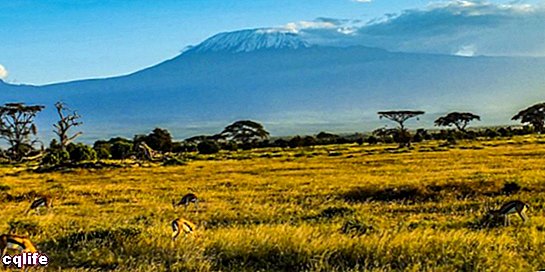- ¿What is the savannah?
- Characteristics of the savanna
- Types of savanna
- Savannah climate
- Savannah fauna
- Savanna flora
- African savanna
- Importance of the savannah
We explain what the savanna is, its characteristics, its importance and the types of savanna that exist. Also, how is its climate, fauna and flora.

¿What is the savannah?
The savanna is a type of ecosystem formed by a wide plain covered with grasslands and herbs in which there are few scattered trees. The savannas are located in tropical and subtropical areas and are characterized by being a transition zone between the semi-desert and the jungle.
Savannas usually have two distinct seasons, one that is warm and dry and the other that is humid and hot. Due to this, many of the animals that inhabit the savannah migrate in the dry season. This type of ecosystem is characterized by having a soil lacking in nutrients in which grasslands that are light green or yellow grow.
The areas in which the savannas predominate are the African continent (known as the African savanna), South America, Australia and India. One of the most recognized is the Serengeti savanna in Tanzania.
Characteristics of the savanna
Some characteristics of the sheets:
- They are a type of ecosystem with a dry and warm climate.
- They have two distinct seasons: a wet and a dry one.
- They have an arid soil with few nutrients.
- They have a fauna adapted to the type of weather and with species that migrate during the dry season.
- They have a flora made up of grasslands that is adapted to the dry climate and the lack of nutrients in the soil.
- They are located in areas close to the tropics, especially in the southern hemisphere of the planet.
Types of savanna
There are different types of savannas, which vary depending on their climate and geographical location. These are:
- Intertropical savanna. A type of savanna located in areas of the tropics and presenting two well-contrasted seasons: one with rainfall and the other dry. The intertropical savanna is also called plain, chaparral, pampas, meadow or pasture. The soil is not very fertile, has a reddish color due to its richness in iron and, when it is the rainy season, it can form swampy areas.
- Temperate savanna. A type of savanna that has a humid climate (although winter is dry and cold) and that has a richer soil than the rest of the savannas.
- Mediterranean or semi-arid savanna. Type of savanna located in mid-latitudes that has a semi-arid and very poor soil.
- Mountainous savanna. Type of savanna that is in very high areas (alpine and subalpine) and characterized by a large amount of rainfall, which allows the development of various species of animals and plants.
Savannah climate
The savannah has a warm temperature throughout the year, with an approximate average of 17 ºC and with few fluctuations of temperature.
The climate of the savannah is marked by two seasons: one with a lot of rainfall, which can cause floods, and another with severe droughts, which can naturally cause fires.
The dry season coincides with winter, when the lowest temperatures occur (20 ºC average). On the other hand, the wet season occurs during the summer and there are higher temperatures and average rainfall of between 750 and 1300 millimeters per year.
The I usually in the savannah it is sandy and dry and with a low presence of nutrients. It is usually a reddish soil due to the strong presence of iron.
Savannah fauna

Savanna animals vary depending on the type of savanna in question. Due to climate variations, many of the species migrate in the dry season, so most mammals have long, strong legs that help them travel long distances.
In the case of birds, they have wide wings to be able to travel long distances at low altitude or long legs, as in the case of ostriches.
In the savannah also live insects and reptiles small ones that take refuge under the ground, such as beetles, grasshoppers, termites, snakes, arachnids, among others.
Savanna flora
The vegetation that inhabits the savannas has developed techniques to survive in times of drought and in soils with few nutrients.
Many of the species of plants of the savannah have roots that store Water and that are usually at great depth to capture nutrients from the soil. At other times, the seeds are very resistant to cold temperatures and lack of water.
In this type of ecosystem there are abundant shrubs, grasses, thorns and bushes and some trees that are scattered throughout the landscape.
African savanna

One of the most important and recognized savannahs in the world is the African savanna, which stretches across the central part of Africa and encompasses the countries of Kenya, Tanzania, Zambia, Chad, Sudan, Ethiopia, Somalia, Zimbabwe, Mozambique, Botswana, and South Africa. .
The temperature in the African savanna oscillates around 23 ºC and it is an ecosystem characterized by its scenery with a typical vegetation formed by herbaceous, grasses, such as rhodesian grass, grasses and trees such as acacias (acacia arabica, acacia Senegal, acacia tortilis), sycamores and baobabs.
The African savanna abounds with mammals predators, since the grasslands allow them to have a wide vision. Consequently, there are pumas, cheetahs, lions, cheetahs, hippos, deer, among others.
In addition, it is inhabited by reptiles such as snakes, crocodiles and turtles and mammals herbivores such as antelopes, giraffes, zebras, elephants, rhinos, and buffalo.
Importance of the savannah
The savannah is a very important type of ecosystem due to the great variety and quantity of animal and plant species that inhabit it. Adverse weather conditions and recurrent droughts made the savannah an area with little urban development and farming, which allowed the advancement of natural fauna and flora. However, poaching, illegal trafficking of wild animals and the natural resources exploitation they put the landscape and the ecological wealth of the savannah at risk.
Poaching is one of the main responsible for the extinction of natural life in the African savannah. Mammals such as elephants, rhinos and tigers are captured through illegal hunting to obtain their horns and tusks, which are then sold at very high prices. These illegal practices lead year after year to a significant decline in indigenous animals. The environmental impact that supposes the loss of the typical fauna of the savannah must be taken into account to fight in defense of this ecosystem.
